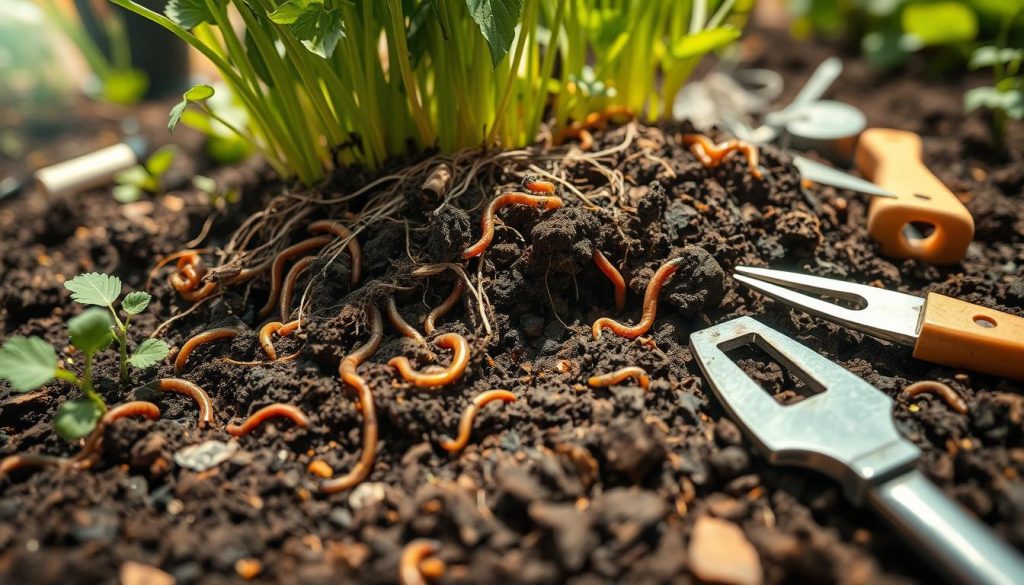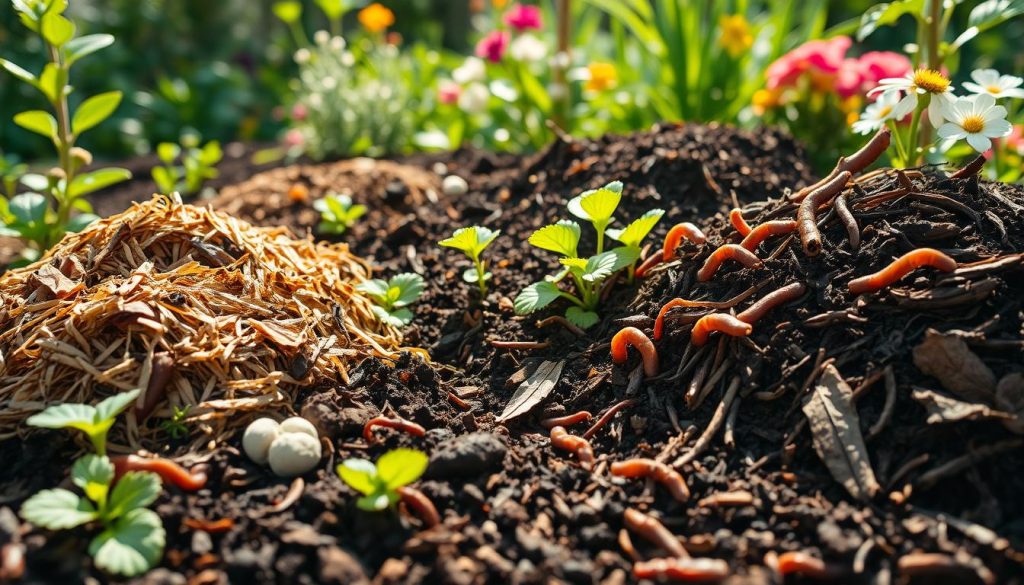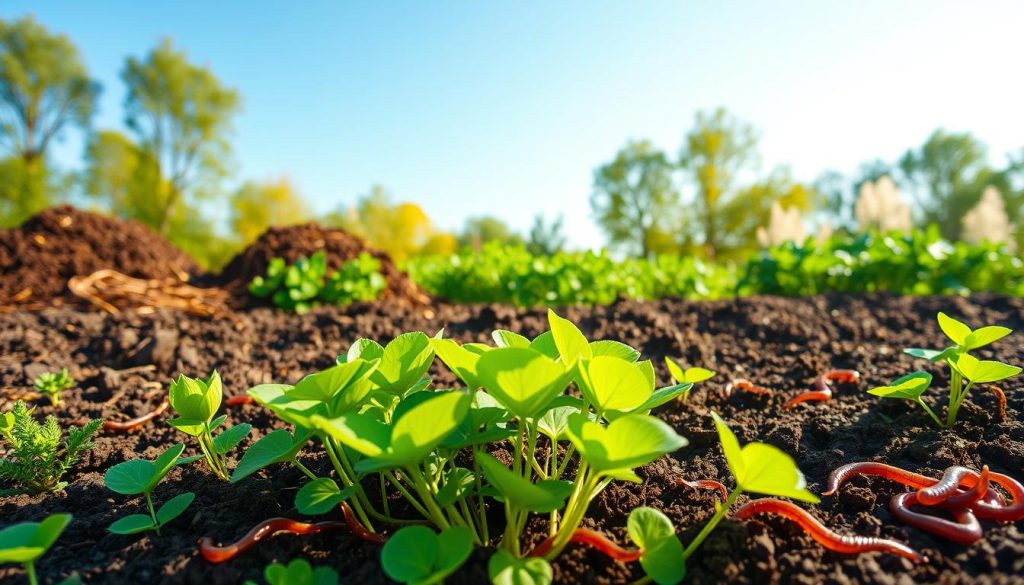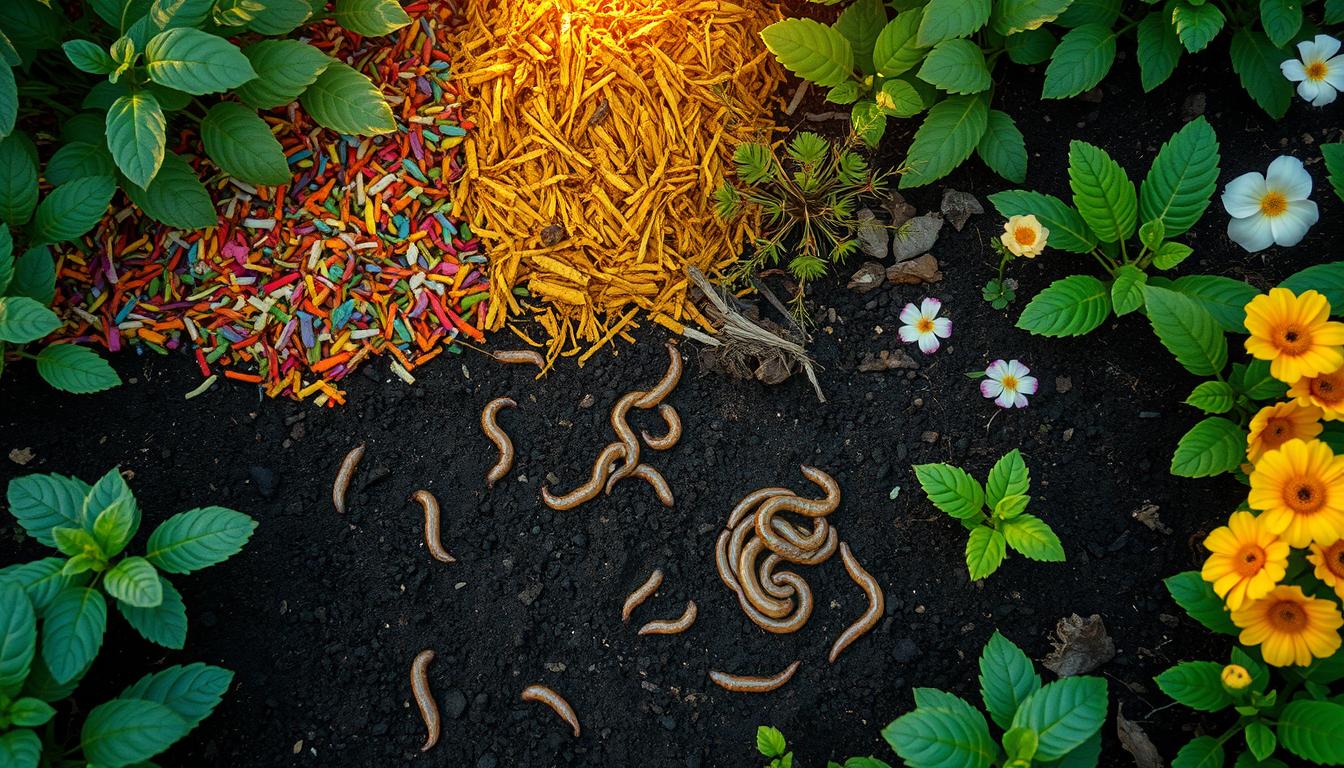As a gardener, I know how important healthy soil is for plants. I’m excited to share how to make your soil better. By doing this, you’ll help your plants grow well.
In this article, I’ll show you how to change your soil for the better. We’ll start by checking your soil’s current state. Then, we’ll make changes to make it healthier. Whether you’re new to gardening or have been doing it for years, you’ll find useful tips here.
Understanding Soil Quality
To improve soil health, we must first understand what soil quality is. It’s about how well the soil supports plant growth and keeps ecosystems healthy. As a gardener, I’ve found that managing soil health is key. It depends on factors like soil texture, structure, and nutrients.
Managing soil health means using practices that boost natural fertility. Adding compost to the soil is a great way to do this. It helps the soil hold water better, breathe, and drain well. These are all signs of healthy soil that help plants grow.
Some important signs of healthy soil include:
- Good drainage
- Aeration
- Water-holding capacity
These signs are crucial for keeping soil healthy and fertile naturally. By knowing these, gardeners can check their soil’s health and find ways to improve it.

By using soil health management practices, gardeners can make their soil better. This leads to healthier plants, more crops, and a greener gardening way. I’ve seen the good effects of these practices myself, and I recommend them to everyone to better their soil.
Assessing Your Soil Health
To check your soil’s health, you need to do a soil test. This test shows your soil’s pH, nutrient levels, and more. Knowing these details helps you find ways to make your soil better.
Conducting a Soil Test
To test your soil, take a sample from your garden or yard. Then, send it to a lab for analysis. Or, you can use a DIY kit to test it yourself. Make sure to follow the kit’s instructions for accurate results.
Interpreting Soil Test Results
After getting your test results, it’s time to understand them. Look at the pH, nutrient levels, and other important factors. Use this info to plan how to improve your soil. Some key things to check include:
- Soil pH: Most plants like a pH between 6.0 and 7.0.
- Nutrient levels: Check the nitrogen, phosphorus, and potassium levels.
- Organic matter: Aim for 25% organic matter and 75% minerals in your soil.
By following these steps and using the right techniques, you can make your soil healthier. 
| Soil Factor | Optimal Level | Your Soil Level |
|---|---|---|
| Soil pH | 6.0-7.0 | Insert your soil pH level here |
| Nitrogen | 10-20 ppm | Insert your nitrogen level here |
| Phosphorus | 5-10 ppm | Insert your phosphorus level here |
Improving Soil Structure
To make your garden thrive, improving soil structure is key. Organic soil amendments are a great way to do this. They make the soil hold more water and air, helping plants grow better and preventing soil erosion.
Adding compost or manure to the soil can greatly improve it. This organic matter breaks up hard soil, letting roots grow deeper and water soak in better. Here are some tips for aerating your soil:
- Adding organic matter like compost or manure to the soil
- Using a fork or spade to loosen compacted soil
- Creating a layer of mulch to help retain moisture and suppress weeds
Good soil structure is vital for healthy plants. Organic amendments and aeration help create this. This leads to stronger plants, better crops, and a greener garden.

| Soil Amendment | Benefits |
|---|---|
| Compost | Improves soil structure, increases water-holding capacity, and supports beneficial microorganisms |
| Manure | Enhances soil fertility, improves soil structure, and provides nutrients for plant growth |
Enhancing Nutrient Content
To make your garden thrive, focus on healthier soil. Compost, mulch, and fertilizers are key. They boost soil nutrients, making plants healthier and your garden more sustainable.
Start with composting for better soil. It breaks down organic stuff like food scraps and leaves into a rich soil mix. You can do this at home with a bin or pile. Add this compost to your soil to improve its health and fertility.
Using Compost Effectively
To use compost well, add it in the right amounts and at the right time. Mix 2-4 inches of compost into the top 6-8 inches of soil. You can do this before planting or around existing plants.
Benefits of Mulching
Mulching also boosts soil quality. It keeps moisture in and weeds out, reducing the need for harmful chemicals. Organic mulches like wood chips or straw add nutrients as they decompose.

Selecting the Right Fertilizers
Choose fertilizers that are good for your soil and the environment. Opt for “slow-release” or “organic” options. Fish emulsion and bone meal are good choices.
By using these tips and methods, you can create a sustainable and productive garden. Always keep your soil healthy, as it’s the heart of a successful garden.
| Soil Amendment | Benefits |
|---|---|
| Compost | Improves soil structure, increases fertility |
| Mulch | Retains moisture, suppresses weeds |
| Fertilizers | Provides essential nutrients for plant growth |
Managing pH Levels
Soil pH is key to soil health. It affects how plants get nutrients. If pH levels are too high or low, plants can suffer. Testing and adjusting pH helps plants grow better and prevents nutrient shortages.
To manage pH, you need to know how to test it. Use a soil testing kit or send a sample to a lab. Then, add lime to raise or sulfur to lower it. Remember, each plant has its own pH needs.
Testing Soil pH
Testing soil pH is easy at home. Buy a kit at a gardening store or online. These kits have a solution and a color chart to read pH levels. Or, send a sample to a lab for detailed results.
Adjusting pH: Tips and Techniques
Adjusting pH needs thought about your plants and soil’s pH. Here are some tips:
- Add lime to raise pH, but don’t overdo it. Too much can harm plants.
- Use sulfur to lower pH, but it takes longer to work.
- Organic matter like compost or manure can adjust pH and improve soil health.
With these tips, you can manage your soil’s pH. This helps plants grow well, which is vital for natural soil fertility.
| pH Level | Plant Growth |
|---|---|
| Too acidic (below 6.0) | Stunted growth, nutrient deficiencies |
| Optimal (6.0-7.0) | Healthy growth, optimal nutrient uptake |
| Too alkaline (above 7.0) | Stunted growth, nutrient deficiencies |
Encouraging Soil Microorganisms
To improve soil sustainably, we must focus on the tiny creatures in it. Beneficial microbes, like bacteria and fungi, are key. They break down organic matter and make nutrients for plants. Organic soil amendments help these microbes thrive.
Importance of Beneficial Microbes
Beneficial microbes are vital. They break down organic matter and make minerals available to plants. They also fight plant diseases and pests, reducing the need for harmful chemicals.
Some key benefits include:
- Improved soil structure and fertility
- Increased plant growth and yields
- Enhanced nutrient cycling and availability
- Reduced soil-borne diseases and pests
Ways to Promote Healthy Microbial Activity
To boost microbial health, we need to give them food, shelter, and water. Adding compost or manure and using no-till farming helps. Cover crops and crop rotations also diversify the soil microbiome.
Implementing Crop Rotation
To make your soil healthier, try crop rotation. It’s a top method for better soil. By changing crops on the same land, you build a strong, diverse ecosystem. This system fights off environmental stresses better.
Rotating crops also lowers pest and disease risks. These can harm your crops and soil quality. It’s a smart way to keep your soil healthy.
For better soil, rotate crops with different needs and growth patterns. Legumes, like beans, add nitrogen to the soil. Cereals, like wheat, need more nitrogen. This balance reduces fertilizer use.
- Improved soil fertility and structure
- Increased crop yields and better plant growth
- Reduced risk of pests and diseases
- More efficient use of water and nutrients
By using crop rotation and other soil methods, you can make your garden sustainable. It will be productive and good for you and the planet.
Water Management for Soil Health
Proper water management is key for healthy soil and preventing erosion. As a gardener, I’ve found that good irrigation and drainage are vital. Techniques like mulching and crop rotation have helped improve my soil’s health. Sustainable soil improvement takes time, but it’s worth it.
To water efficiently, consider your soil, climate, and plants. Here are some tips for better irrigation:
- Use drip irrigation or soaker hoses to water plants’ roots directly
- Install rain barrels or cisterns to save rainwater for irrigation
- Water on a schedule, based on weather and soil moisture
These methods help avoid waterlogged soil and promote plant growth. Proper drainage is also crucial to prevent water buildup and erosion. By using organic matter and sustainable strategies, gardeners can create a thriving soil ecosystem.
Effective water management reduces soil erosion and makes gardening more sustainable. This leads to healthier plants, better soil, and a stronger ecosystem. As a gardener, I’ve seen the benefits of proper water management and sustainable soil improvement. I encourage others to try these strategies in their gardens.
| Soil Enhancement Techniques | Benefits |
|---|---|
| Mulching | Improves soil structure, reduces erosion |
| Crop Rotation | Improves soil fertility, reduces pests and diseases |
| Adding Organic Matter | Improves soil structure, increases water retention |
Minimizing Soil Erosion
To keep soil healthy, we must stop erosion. Erosion can happen from water, wind, or human actions. Knowing why erosion occurs is key. By taking steps to prevent it, we can keep our soil stable and fertile.
Some ways to stop erosion include:
- Planting groundcover or native plants to keep soil in place
- Using mulch or compost to make soil stable and stop runoff
- Building terraces or berms to control water flow
- Using conservation tillage to disturb soil less
By using these methods, we can keep our soil quality high. This helps our ecosystem stay healthy and productive.
Soil erosion is bad news. It can lead to lost fertile land, more sediment in water, and lower crop yields. So, we must act now to protect our soil.
Good soil health management means using these strategies. We need to work together to stop erosion and keep our soil fertile. This way, we can ensure a better future for our planet.
| Method | Description | Benefits |
|---|---|---|
| Planting groundcover | Stabilizes soil and prevents erosion | Reduces soil loss, promotes biodiversity |
| Using mulch or compost | Stabilizes soil and reduces runoff | Improves soil fertility, reduces erosion |
Practicing Sustainable Land Use
Exploring ways to improve soil health has shown me the value of sustainable land use in gardening. Sustainable practices help gardeners lessen their environmental impact. They also make their gardens more resilient and productive. Key to this is using organic soil amendments to boost soil health.
Benefits of sustainable gardening include less waste, better soil, and more biodiversity. To garden sustainably, try these tips:
- Use organic soil amendments, such as compost or manure, to improve soil fertility and structure
- Reduce waste by composting food scraps and yard trimmings
- Conserve water by using efficient irrigation systems and collecting rainwater
Adding these sustainable practices to your gardening routine helps the environment and soil quality. Sustainable soil improvement is a long-term effort. It needs patience, dedication, and a willingness to learn and adapt. Together, we can make our gardens and planet more sustainable.
Regular Maintenance and Monitoring
Keeping soil healthy is a continuous effort, but it’s worth it. As a gardener, I’ve found that a regular maintenance plan is essential. It keeps my soil rich and vibrant all year.
Setting Up a Maintenance Schedule
I suggest doing a detailed soil test every 2-3 years. This checks pH, nutrients, and organic matter. It helps me adjust with lime or compost to keep the soil perfect.
I also remember to aerate and add mulch seasonally. This improves air and water flow in the soil.
Keeping Track of Soil Changes Over Time
Recording soil test results and any changes I make helps me see how my soil evolves. This way, I can spot trends and fix issues early. Watching my plants grow also shows me if my soil care is working.
Keeping soil healthy is a journey, but it’s very rewarding. With a steady routine and attention to soil changes, my garden stays vibrant for years.

